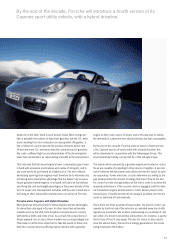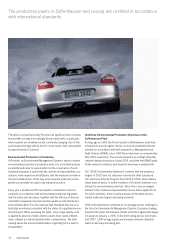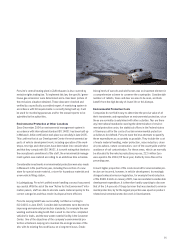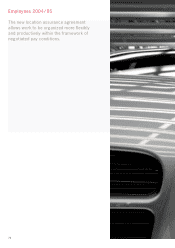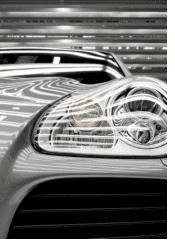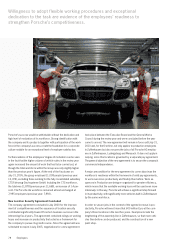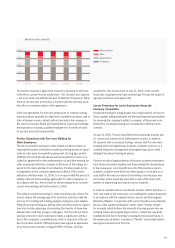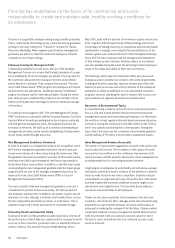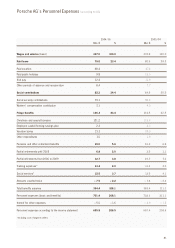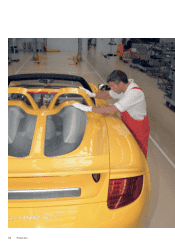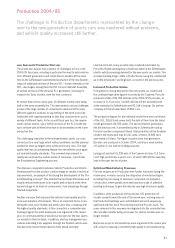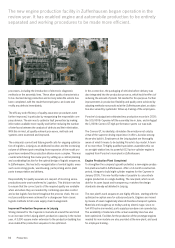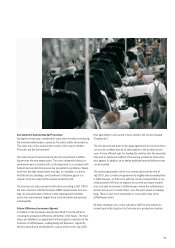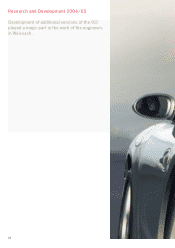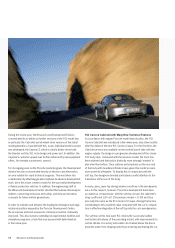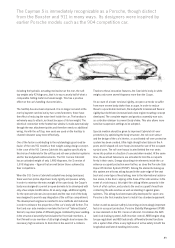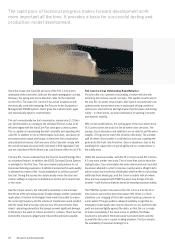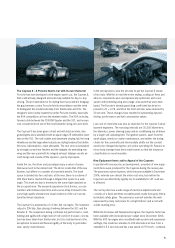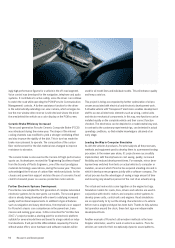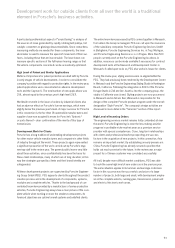Porsche 2004 Annual Report Download - page 87
Download and view the complete annual report
Please find page 87 of the 2004 Porsche annual report below. You can navigate through the pages in the report by either clicking on the pages listed below, or by using the keyword search tool below to find specific information within the annual report.
83
Production 2004 ⁄ 05
The challenge to Production departments represented by the change-
over to the new generation of sports cars was mastered without problems,
and vehicle quality increased still further.
Successful Production Start-ups
The production division had a number of challenges to face in the
2004/05 fiscal year, including in particular the need to build vehicles
from different generations and model lines in parallel. At the same
time as the Zuffenhausen plant started production of the new Boxster,
output of additional versions of the new 911 – known internally as the
997– also began, among them the 911 Carrera Cabriolet. Assembly
of various versions of the previous 911 generation, including for
instance the Turbo models, none the less continued.
At certain times in the review year, 16 different models were being
built on the same assembly line. This represented a serious challenge,
in view of the large number of components needed and the many
different suppliers involved, to say nothing of the need to provide
employees with ongoing training so that they could perform such a
variety of different tasks. In the current fiscal year too, the require-
ments remain severe, since further versions of the 911 model line
such as those with all-wheel drive have to be assembled on the same
production line.
The challenging transition to the new-generation sports cars was
carried out to a very large extent without problems, and the planned
production start-up targets were achieved in every case. The high
quality level was an outstanding feature: the new vehicles once again
set new build quality standards. This renewed improvement in
quality was achieved by a whole series of measures, in particular
the Simultaneous Engineering process.
The intensive cooperation between Vehicle Production and Vehicle
Development from the product creation stage on results in technical
improvements, an example of this being the development of the ‘Por-
sche Mounting Concept’. This enables the functional dimensions and
visually relevant tolerances to be significantly reduced at the deve-
lopment stage on all kinds of components, from stampings through
finished bodyshells.
Another measure that improved the vehicles’ build quality was the
increased adoption of teamwork. This is an important factor in ren-
dering the work more flexible and at the same time complying with
the highest quality standards. In this connection a comprehensive
training program for plant employees was organized in the review
year, to communicate the production processes for the new sports
car models to them in detail. In addition, start-up management pro-
cedures extending from suppliers through the finished vehicle were
introduced to ensure that production went ahead smoothly.
Last but not least, every possible step rendered practicable by
Porsche’s flexible working-hours model was taken at the Zuffenhausen
plant to satisfy increasing demand for the new sports car models. This
included working longer shifts in Production by using the credits built
up on the employees’ working-hours accounts in the previous year.
Increased Production Volume
In response to strong demand for the new sports car models and
the continued high sales figures recorded by the Cayenne, Porsche
produced a total of 90,954 vehicles in the 2004/05 fiscal year, an
increase of 11.6 percent. 33,048 vehicles left the assembly lines
at the main plant in Zuffenhausen and 42,014 in Leipzig. Our partner-
company in Finland assembled 15,892 cars.
The production figures for the individual model lines were as follows:
of the 911, 28,619 units were built, the bulk of them from the latest
model generation (24,596 units). The second Boxster generation,
like the previous one, is assembled jointly in Zuffenhausen and by
Porsche’s partner-company in Finland. Total production of this Roadster
model in the review year was 20,321 units, of which 15,892 were
assembled in Finland. The figure includes a few first-generation
Boxster cars produced in October 2004, and also a small number
of Cayman S cars built for testing purposes.
Leipzig not only built 41,299 units of the Cayenne but also 715 Carre-
ra GT high-performance sports cars, of which 985 left the assembly
lines in the past two fiscal years.
Optimized Manufacturing Processes
Process sequences in Production were further improved during the
review year, in many cases by the integration of new technologies,
including the processing of aluminum components in bodyshell
construction, where greatly increased use was made of adhesive
bonding techniques to give the vehicles very high structural rigidity.
In addition, when production of the previous 911 generation of
models ceased toward the end of the review year, working areas in
the Production buildings were redistributed and work sequences
optimized with the aid of Porsche Improvement Process tools. The
areas released in this way were re-integrated into the assembly lines
after parallel manufacturing processes for various models were no
longer needed.
Numerous projects and workshops were organized in the review year
with a view to assuring consistently high quality in all manufacturing


